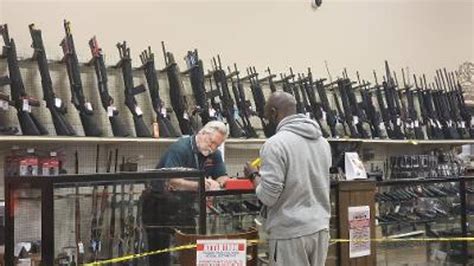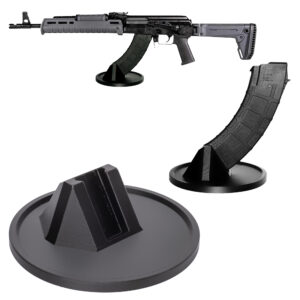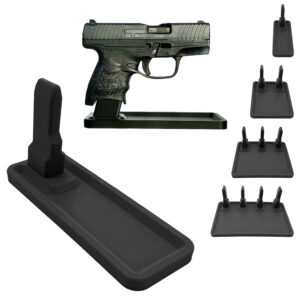
Categories:
Understanding the importance of guns safety is essential for anyone involved in handling, owning, or teaching about guns. The significance of this subject lies in its potential to prevent accidents and ensure the wellbeing of individuals and the community. Guns, by design, are powerful tools capable of exerting substantial force, and their misuse or mishandling can lead to tragic consequences. Emphasizing safety not only protects lives but also upholds the integrity and responsibility associated with gun ownership.
At the core of guns safety is the principle that knowledge mitigates risk. Education in this area equips individuals with the necessary skills to handle guns with care and precision, fostering an environment of respect and caution. Understanding and adhering to basic safety rules, such as always treating a gun as if it is loaded and knowing the target and what lies beyond it, are fundamental elements of responsible gun usage.
These practices prevent negligent discharges and unintentional injuries, reducing the risk of harm.
Moreover, guns safety goes beyond the technical aspects of handling weapons. It involves a mindset that prioritizes discipline and awareness, recognizing that each decision made while handling a gun can have significant repercussions. By embedding safety into the culture of guns use, individuals develop a sense of responsibility not only for their own safety but also for that of others. This cultural shift can lead to a reduction in the number of gun-related accidents and incidents, thereby creating safer communities.
Instructing courses in guns safety also plays a critical role in reinforcing these values. Trained professionals can impart their experiences and knowledge to others, providing hands-on education that emphasizes real-world applications. Guns safety courses are an invaluable resource in promoting best practices, and they lay the groundwork for a community that respects and understands the potential dangers of guns, while also recognizing their safe use.
By fostering a comprehensive understanding of guns safety, we contribute to a culture where responsible management of guns becomes the norm, ultimately safeguarding lives and promoting peace of mind.
Selecting qualified instructors for your guns safety course is a crucial aspect of ensuring that participants receive the highest level of education and safety training. The right instructor not only possesses a deep understanding of guns and safety procedures but also has the ability to effectively communicate this knowledge to students. The process begins by establishing the qualifications necessary for an instructor to teach your course.
Potential candidates should have extensive experience with guns, often illustrated through professional credentials such as certifications from recognized national organizations or law enforcement agencies. Their backgrounds should include experience in both guns usage and safety management.
Equally important is the instructor’s teaching capability. Even the most knowledgeable professional needs the skills to convey complex information in an understandable way. Therefore, an ideal candidate should have prior teaching or training experience and demonstrate excellent communication skills. Observing a potential instructor in action, if possible, can provide insights into their teaching style and interaction with students. References and testimonials from previous students can also serve as valuable resources in evaluating an instructor’s effectiveness.
It’s vital to consider the instructor’s approachability and demeanor. An instructor who can create a supportive and engaging atmosphere is more likely to facilitate a positive learning experience, which is crucial in a setting that can be intimidating for newcomers. Moreover, ensure the instructor is adept at fostering an environment where participants feel comfortable asking questions and discussing any concerns.
An instructor’s commitment to continuous learning is another significant factor. This industry evolves, with new practices and technologies emerging regularly. Instructors who engage in ongoing education and participate in professional development opportunities are more likely to provide up-to-date information and techniques.
Ultimately, selecting the right instructor requires a balance of expertise, teaching acumen, interpersonal skills, and a dedication to safety and ongoing education. This discernment will lead to a course that not only meets but exceeds safety and educational standards.
Designing a comprehensive curriculum for hosting guns safety courses requires a clear understanding of the fundamentals necessary for safe gun handling and operation. The curriculum should begin with a strong emphasis on the basic principles of gun safety. This includes the essential tenets such as treating every gun as if it is loaded, always pointing the muzzle in a safe direction, keeping your finger off the trigger until you are ready to shoot, and being certain of your target and what is beyond it.
These foundational rules must be continuously reinforced throughout the course to instill them as habits.
Moreover, the curriculum should incorporate detailed information about different types of guns and their components. Students should learn to identify parts of the gun, understand how each part functions, and become familiar with various models’ similarities and differences. This knowledge empowers participants to safely handle any gun they encounter.
Practical skills training should be a significant component of the curriculum. Live demonstrations and hands-on practice sessions allow students to apply what they have learned in a controlled environment. This aspect should cover everything from loading and unloading, proper grip, stance, and aim, to maintaining control under varied conditions. Instructors should provide individual feedback to enhance learning and build confidence among participants.
Another critical aspect is the inclusion of legal considerations and an understanding of the local laws related to guns possession, transportation, and use. This knowledge ensures that participants are not only technically proficient but also legally aware and responsible gun users.
Additionally, the curriculum should present scenarios and case studies that encourage critical thinking and decision-making. These simulations prepare participants to handle potential real-world situations safely and effectively. The course should conclude with an assessment to evaluate each participant’s grasp of the material, ensuring they leave with the competence and confidence to handle guns safely. Integrating these elements creates a robust and comprehensive guns safety course that addresses both theoretical knowledge and practical skills.
When preparing to host guns safety courses, selecting an appropriate venue is crucial to ensure a conducive learning environment and prioritize safety. The ideal venue should marry accessibility, safety considerations, and environmental suitability to support the instructional objectives. Choosing a location that is geographically convenient for participants can facilitate better attendance and engagement. It is important to consider proximity to major transportation routes and public transit options, making the course accessible for both local and distant participants.
Safety is paramount when planning any event that involves guns. The venue should have designated areas for theoretical instruction—such as classrooms or conference rooms—and secure, isolated areas for practical demonstrations and handling exercises, ideally an accredited shooting range. The shooting range should comply with all local, state, and federal regulations, have proper safety measures in place, such as bulletproof partitions and soundproofing, and be equipped with first aid and emergency response systems.
Range officers should be present to ensure that all safety protocols are strictly followed during practical exercises.
Environmental suitability also plays a significant role in the selection process. Ensure that the site caters to various comfort needs, providing essential amenities such as restrooms, adequate seating, good lighting, ventilation, and perhaps catering options. The venue should also facilitate effective communication during demonstrations and instructions, which might necessitate audio-visual aids, Wi-Fi access, and power outlets for presentations.
A significant focus should be placed on security measures to prevent unauthorized access to guns during the course. Only registered participants should have access to the training space, and an inventory system should be in place to track guns and equipment. Insurance and liability coverage must also be arranged to protect both the instructors and participants. By carefully considering these aspects, the right venue can enhance the learning experience while maintaining the stringent safety standards required in guns training courses.
Marketing your guns safety course effectively is crucial for attracting participants and establishing a reputation as a reliable and knowledgeable instructor. To start, identify your target audience, which may include new gun owners, hunters, security personnel, or even families interested in home defense. Understanding their needs and interests will allow you to tailor your marketing messages to resonate with them specifically.
Begin by creating a professional and informative online presence. A well-designed website should serve as a hub for all your marketing activities, offering detailed course descriptions, schedules, pricing, and instructor credentials. Consider adding testimonials and reviews from past participants to build credibility. Social media platforms offer an excellent opportunity to engage with potential students and share valuable content, such as safety tips, industry news, or success stories from your past courses.
Use these channels to establish a community and foster discussions around guns safety.
Networking can also play a significant role in expanding your reach. Forge relationships with local gun stores, shooting ranges, and gun clubs to explore partnership opportunities. They might be willing to promote your courses in exchange for a referral fee or a mutually beneficial collaboration. Offering free introductory workshops or seminars can also serve as a powerful marketing tool. These events give potential students a taste of what they can expect from your paid courses, showcasing your expertise and the value of your training.
Leverage online advertising to reach a broader audience. Platforms like Google Ads or Facebook can target specific demographics, ensuring your message reaches those most likely to enroll. Finally, don’t underestimate the power of word-of-mouth marketing. Encourage satisfied students to refer friends and family, perhaps by offering incentives such as discounts on future courses. By employing a strategic mixture of digital and traditional marketing techniques, you can effectively promote your guns safety course and attract a steady stream of participants.
Managing registration and attendance for guns safety courses is a crucial component to ensuring the success and smooth execution of the program. Given the serious nature of handling guns, it is imperative that these courses are meticulously organized to accommodate all participants effectively while maintaining a focus on safety and education.
The registration process is the first step in managing attendance and should be designed to be as efficient and straightforward as possible. An online registration system can be an effective tool, allowing participants to easily sign up for courses, view available dates, and manage payments. It is essential to provide clear information about the requirements for participation, such as age restrictions, necessary documentation, and pre-requisite knowledge or experience with guns.
Once registration is complete, maintaining an accurate record of attendees is vital. This involves confirming each participant’s details and ensuring they have completed any necessary pre-course work or assessments. Sending confirmation emails that include detailed information about the course, such as location, schedule, and what to bring, can help participants arrive prepared and reduce no-show rates.
On the day of the course, efficient check-in procedures can facilitate smooth attendance management. Arriving early to set up a check-in station and welcoming attendees as they arrive helps foster a positive atmosphere and ensures everyone is accounted for. Verifying each participant’s identity and confirming their registration status is essential for not only managing attendance but also ensuring safety.
Throughout the course, maintaining an attendance log is important for compliance and future reference. Tracking attendance can help identify patterns such as high no-show rates, which can inform future improvements to registration processes or the scheduling of courses.
Effective communication with participants before, during, and after the course, complemented by organized registration and attendance management, enhances the overall experience and ensures that the guns safety course is conducted efficiently and securely. This attention to detail fosters a professional learning environment where participants can focus on learning critical safety skills.
Evaluating and improving the effectiveness of guns safety courses is crucial to ensure participants gain the necessary knowledge and skills to handle guns safely and responsibly. Continuous assessment and enhancement of these courses contribute significantly to the overall goal of reducing guns-related accidents and promoting responsible gun ownership.
The first step in evaluating effectiveness is to implement a comprehensive feedback mechanism. Participants should be encouraged to provide honest and detailed feedback on various aspects of the course, including content, delivery, and practical exercises. Surveys and questionnaires can be employed to gather this feedback, while exit interviews provide an opportunity for more in-depth discussions. Instructors should also be urged to self-assess, reflecting on their teaching methods and the engagement levels of their students.
Analyzing the collected data is essential to identify areas needing improvement. Patterns in feedback can reveal specific topics where participants feel inadequately prepared or areas where instructional methods fall short. For instance, if participants consistently express difficulty in understanding a particular safety procedure, it may indicate the need for more practical demonstrations or a different instructional approach.
Regular updates to the curriculum are vital to maintain its relevance and comprehensiveness. Guns safety courses should incorporate the latest research findings, legal requirements, and technological advancements in the field. Engaging with industry professionals and regulatory bodies can provide valuable insights into new safety protocols and emerging risks, ensuring that the course content remains current and effective.
Incorporating a variety of teaching methods can also enhance course effectiveness. A blend of traditional lectures, interactive sessions, and hands-on experiences caters to different learning styles and can help solidify the knowledge being imparted. Evaluators should consider the balance between these elements and adjust accordingly to improve knowledge retention and practical application.
Ultimately, fostering a culture of continuous improvement is key. Creating avenues for instructors to share best practices and engage in professional development ensures that they remain competent and confident in delivering quality education. By systematically assessing and refining guns safety courses, we can ensure they meet the highest standards, imparting critical skills and enhancing the safety and responsibility of all participants.








Colt
Colt M4 Carbine
Colt LE6920
Colt AR-15 A4
Daniel Defense
DDM4 V7
DDM4 V9
DDM4 V11
DDM4 ISR (Integrally Suppressed Rifle)
Smith & Wesson (S&W)
M&P15 Sport II
M&P15 Tactical
M&P15T
Bravo Company Manufacturing (BCM)
BCM Recce-16
BCM Recce-14
BCM MCMR Series
Aero Precision
M4E1 Series
AC-15
AR15 Pistol (Various Configurations)
Ruger
Ruger AR-556
Ruger SR-556
Ruger AR-556 MPR (Multi-Purpose Rifle)
Springfield Armory
Saint Victor
Saint Edge
Saint AR-15
PSA (Palmetto State Armory)
PSA PA-15
PSA AR-V
PSA Jakl (AR Pistol)
FN America
FN 15 Tactical Carbine
FN 15 Patrol
FN 15 DMR
Wilson Combat
Recon Tactical
Super Sniper
Protector Carbine
SIG Sauer
SIG M400 Tread
SIG M400 Elite
SIG M400 SDI
LWRC International
IC DI (Direct Impingement)
IC SPR
IC A5
Bushmaster Guns
XM-15 QRC
Bushmaster MOE
XM-15 Patrolman
Rock River Arms
LAR-15 Entry Tactical
LAR-15 Predator
LAR-15 Elite Comp
Stag Arms
Stag 15 Tactical
Stag 15L (Left-Handed Models)
Stag 15 Valkyrie
Noveske Rifleworks
Noveske Gen 4 N4
Noveske Space Invader (AR Pistol)
Noveske Recon
Anderson Manufacturing
AM-15 Optic Ready
AM-15 M4 Carbine
AM-15 Precision Rifle
Adams Arms
AA-15 Piston Rifle
P2 AARS (Adams Arms Rifle Series)
Black Rain Ordnance
SPEC15 Series
BRO Predator
Fallout 15
Diamondback Guns
DB15 Series
DB15CCMLB
DB15EB
Del-Ton Inc.
DTI-15
Del-Ton Echo 316H
Sierra 316M
Windham Weaponry
Windham SRC
Windham VEX-SS
Windham RMCS-4 (Caliber Conversion System)
Christensen Arms
CA-15 G2
CA-15 Recon
CA-15 Titanium Edition
Patriot Ordnance Factory (POF-USA)
Renegade Plus
P415 Edge
Revolution DI
LaRue Tactical
PredatAR
OBR (Optimized Battle Rifle)
LaRue Stealth 2.0
Battle Arms Development
Workhorse Patrol Carbine
BAD556-LW (Lightweight)
Authority Elite Rifle
Faxon Guns
Ascent AR-15
FX-19 (AR Pistol)
Streamline Ultralight Series
KE Arms
KE-15 SLT (Super Lightweight Tactical)
KE-15 Scout Carbine
Primary Weapons Systems (PWS)
MK1 MOD 2-M
MK116 PRO
MK107 (Piston AR Pistol)
ZEV Technologies
ZEV Core Elite Rifle
ZEV AR15 Billet Rifles
Franklin Armory
BFSIII AR-C1
Militia Model
F17-L (Chambered in .17 WSM)
Seekins Precision
SP15 DMR
NX15 Skeletonized Rifle
Havak Bravo
Aero Precision (Additional Models)
EPC-9 (Pistol Caliber ARs)
VG6 AR Rifles
Barrett Guns
REC7 DI
REC7 Gen II
CMMG
MK4 RCE
Resolute 300
Banshee (AR Pistol)
DPMS Panther Arms
Panther Oracle
Panther LR-308
H&K (Heckler & Koch)
HK MR556A1
HK416 (Military Variant)
Rock Island Armory (Armscor)
VR-80 Tactical AR (Shotgun AR Platform)
Troy Industries
Troy SPC-A3
Troy PAR (Pump Action AR)
Wilson Tactical
Tactical Recon AR
Protector Series
F1 Guns
FDR-15 Skeletonized Rifle
BDRx-15 Series
Juggernaut Tactical
JT-15
JT-10 Precision Rifle
AeroSurplus
Surplus AR-15 Rifles (Budget Models)
Thunder Tactical
AR-15 Basic Carbine
Tactical Builder Sets
Radical Guns
RF-15
Forged AR-Series
Dark Storm Industries
DS-15 Featureless Rifles
DS-10 Typhoon
DRD Tactical
Paratus
Aptus AR Rifles
Bear Creek Arsenal
BCA-15
AR Complete Upper Builds
Aero Survival Rifles (ASI)
ASR Tactical Series
Tactical Edge
WARFIGHTER Series
AR-15 Lightweight Rifles
Lone Star Armory
TX15 DMR
TX15 Carbine
HERA Arms
HERA H7
HERA AR-15 Lower Builds
IWI (Israeli Weapon Industries)
Zion-15
DRD Tactical
Tactical Modular Rifles
Quick-Takedown Rifles
V Seven Weapons
1776 Rifle
Hyperlite Rifle
Core Rifle Systems
Core15 Tac III
Core15 Patrol Rifle
Armalite (Original AR-15 Creator)
M15 Tactical
M15 A4 Carbine
DEF15 (Defensive Sporting Rifle Series)
PSA (Palmetto State Armory Additional Models)
PSAK-47 Hybrid (AR-AK Style Hybrid)
PSA Dagger (Pistol Caliber Configurations)
Odin Works
OTR-15
Odin Recon Rifle
Maxim Defense
MDX-508 PDX (Compact AR Pistol)
MDX-510 Rifle